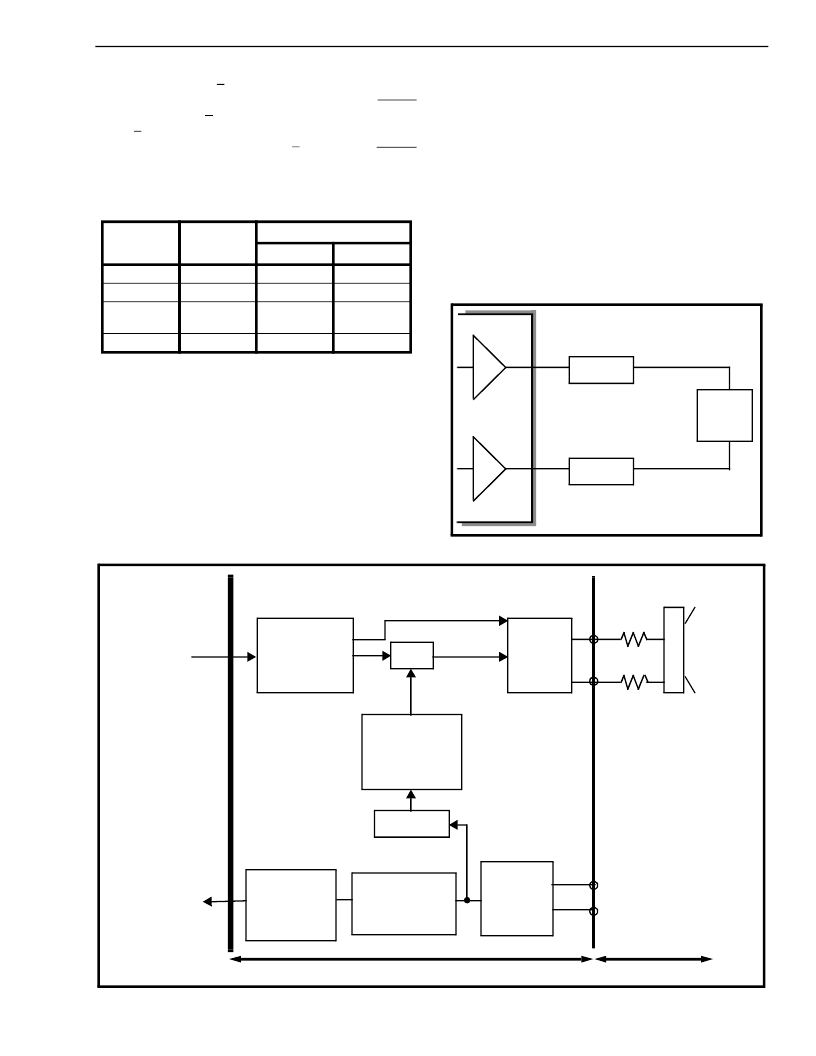- 您現(xiàn)在的位置:買賣IC網(wǎng) > PDF目錄383645 > MT9160AS (Mitel Networks Corporation) ISO2-CMOS 5 Volt Multi-Featured Codec (MFC) PDF資料下載
參數(shù)資料
| 型號: | MT9160AS |
| 廠商: | Mitel Networks Corporation |
| 元件分類: | Codec |
| 英文描述: | ISO2-CMOS 5 Volt Multi-Featured Codec (MFC) |
| 中文描述: | ISO2 - 5伏的CMOS多精選編解碼器(MFC)中 |
| 文件頁數(shù): | 5/28頁 |
| 文件大?。?/td> | 402K |
| 代理商: | MT9160AS |
第1頁第2頁第3頁第4頁當前第5頁第6頁第7頁第8頁第9頁第10頁第11頁第12頁第13頁第14頁第15頁第16頁第17頁第18頁第19頁第20頁第21頁第22頁第23頁第24頁第25頁第26頁第27頁第28頁

Preliminary Information
MT9160
7-81
Companding law selection for the Filter/Codec is
provided by the A/μ companding control bit while
the coding scheme is controlled by the Smag/CCITT
control bit. The A/
μ
control bit is logically OR’ed with
the A/
μ
pin providing access in both controller and
controllerless modes. Both A/
μ
and Smag/CCITT
reside in Control Register 2 (address 04h). Table 1
illustrates these choices.
Table 1
Transducer Interfaces
Standard handset transducer interfaces are provided
by the MT9160. These are:
The handset microphone inputs (transmitter),
pins M+/M-. The nominal transmit amplifier gain
may be adjusted to either 6.0 dB or 15.3 dB.
Code
Sign/
Magnitude
CCITT (G.711)
μ-Law
A-Law
+ Full Scale
1111 1111
1000 0000
1010 1010
+ Zero
1000 0000
1111 1111
1101 0101
-Zero
(quiet code)
0000 0000
0111 1111
0101 0101
- Full Scale
0111 1111
0000 0000
0010 1010
Control of this gain is provided by the TxINC
control bit (Gain Control register 1, address 00h).
The handset speaker outputs (receiver), pins
HSPKR+/HSPKR-.This internally compensated
fully differential output driver is capable of driving
the load shown in Figure 4. The nominal handset
receive path gain may be adjusted to either 0 dB,
-6 dB or -12 dB. Control of this gain is provided
by the RxINC control bit (Gain Control register 1,
address 00h). This gain adjustment is in addition
to the programmable gain provided by the receive
filter.
Figure 4 - Handset Speaker Driver
HSPKR +
HSPKR -
75
75
150 ohm
load
(speaker)
MT9160
Figure 3 - Audio Gain Partitioning
Serial Port
Filter/Codec and Transducer Interface
Handset
Receiver
(150
)
PCM
D
in
Receive
Filter Gain
0 to -7 dB
(1 dB steps)
Side-tone
-9.96 to
+9. 96 dB
(3.32 dB steps)
-11 dB
-6 dB
Receiver
Driver
-6.0 dB or
0 dB
HSPKR +
HSPKR -
75
INTERNAL TO DEVICE
EXTERNAL TO DEVICE
Default Bypass
M+
M-
Transmit
Gain
6.37 dB
Transmit Gain
-0.37 dB or 8.93 dB
Transmit Filter
Gain
0 to +7 dB
(1 dB steps)
PCM
Transmitter
Microphone
D
out
75
D
相關PDF資料 |
PDF描述 |
|---|---|
| MT9160BN | ISO2-CMOS 5 Volt Multi-Featured Codec (MFC) |
| MT91610 | Programmable Ringing SLIC(可編程振鈴用戶線路接口電路(帶一個外部驅動器)) |
| MT9161B | ISO2-CMOS 5 Volt Multi-Featured Codec (MFC) |
| MT9161BE | ISO2-CMOS 5 Volt Multi-Featured Codec (MFC) |
| MT9161BN | ISO2-CMOS 5 Volt Multi-Featured Codec (MFC) |
相關代理商/技術參數(shù) |
參數(shù)描述 |
|---|---|
| MT9160B | 制造商:MITEL 制造商全稱:Mitel Networks Corporation 功能描述:ISO2-CMOS 5 Volt Multi-Featured Codec (MFC) |
| MT9160BE | 制造商:Microsemi Corporation 功能描述:MULTI-FEATURED CODEC 24PDIP - Rail/Tube |
| MT9160BN | 制造商:Microsemi Corporation 功能描述: |
| MT9160BS | 制造商:Microsemi Corporation 功能描述: |
| MT9160BS1 | 制造商:MICROSEMI CONSUMER MEDICAL PRODUCT GROUP 功能描述:IC CODEC MFC 5V 20SOIC 制造商:Microsemi Corporation 功能描述:IC CODEC MFC 5V 20SOIC |
發(fā)布緊急采購,3分鐘左右您將得到回復。